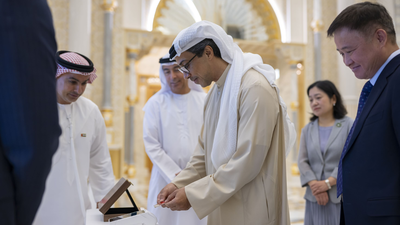The UAE has carried out its first-ever cross-border payment with China using central bank digital currencies, marking a major breakthrough in digital finance and setting the stage for deeper technological and economic cooperation. The transaction, executed through the newly launched ‘Jisr’ platform, was announced alongside new instant payment links and a multi-scheme prepaid card, forming a comprehensive package of initiatives that elevate UAE–China financial integration.
Landmark CBDC transaction and launch of the ‘Jisr’ platform
At Qasr Al Watan in Abu Dhabi, His Highness Sheikh Mansour bin Zayed Al Nahyan, UAE Vice President, Deputy Prime Minister, Chairman of the Presidential Court, and Chairman of the Central Bank of the UAE’s Board, received Pan Gongsheng, Governor of the People’s Bank of China, in the presence of UAE Central Bank Governor Khaled Mohamed Balama.During this meeting, Sheikh Mansour executed the first-ever cross-border payment using central bank digital currency (CBDC) between the UAE and China. The transaction was completed through ‘Jisr’, a newly introduced network designed specifically for CBDC-enabled cross-border transfers.The ‘Jisr’ platform, established with participation from Emirati and Chinese banks, aims to deliver instant settlement, reduce cross-border transaction costs, and support smoother payment flows. The system is scheduled to expand in 2026, with more central banks expected to join, further strengthening the UAE’s growing role in global financial connectivity.
UAE–China instant payment systems interlinked
Ceremonies held during the visit highlighted the successful interconnection of financial infrastructures between both nations. Attendees included Sheikh Mansour, both central bank governors, Zhang Yiming, Ambassador of the People’s Republic of China to the UAE, along with assistant governors and senior officials.One of the central announcements was the interlinking of the UAE’s Instant Payment System with China’s Internet Banking Payment System. This integration enables secure, real-time money transfers available 24/7.The linkage supports multiple use cases, such as:
- Scholarship transfers for Emirati students in China
- Remittances for Chinese residents in the UAE
- Cross-border payments supporting commercial transactions between companies in both countries
The system is expected to improve the speed, efficiency, and reliability of payments, contributing to deeper economic and financial ties.
Launch of the ‘Jaywan–UnionPay’ multi scheme prepaid card
Another milestone unveiled was the official launch of the ‘Jaywan–UnionPay’ prepaid card, the first multi-scheme prepaid card, paired with the execution of its first transaction.Developed through cooperation between Jaywan, the UAE’s domestic card scheme, and UnionPay, the Chinese payment network, the card brings:
- Acceptance in over 180 countries through UnionPay’s global network
- Local processing for transactions conducted within the UAE
- Issuance in partnership with Lari Exchange
The card enhances global usability for UAE-issued payment products while maintaining strong domestic settlement infrastructure.
Strategic MoU signed between central banks
To support continued collaboration, Khaled Mohamed Balama and Pan Gongsheng signed a Memorandum of Understanding (MoU) focused on:
- Enhancing cooperation in cross-border payments
- Developing advanced financial infrastructures
- Supporting joint strategic initiatives that strengthen long-term bilateral partnership
This agreement provides an institutional foundation for expanding the projects introduced during the visit.
Remarks from UAE leadership
Sheikh Mansour highlighted the “depth of the strategic partnership” between the UAE and China, noting that the launch of the ‘Jisr’ platform, the instant payment system interlinking, and the new ‘Jaywan–UnionPay’ card are tangible steps toward a modern, secure financial ecosystem. He emphasised that these developments will support innovation, enable streamlined cross-border payments, and reinforce the UAE’s global leadership in financial technology. Go to Source



